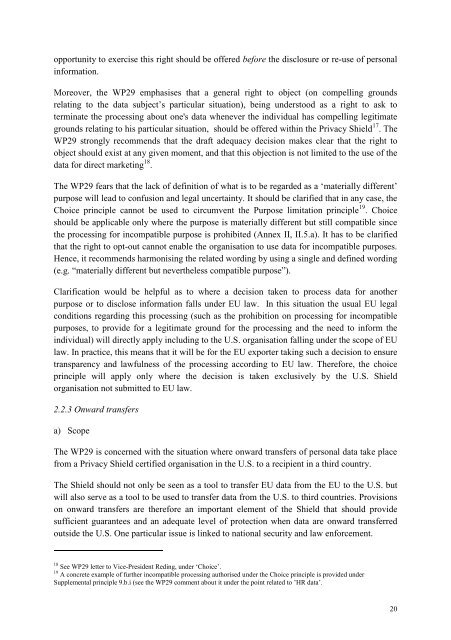ARTICLE 29 DATA PROTECTION WORKING PARTY
1SANK0H
1SANK0H
You also want an ePaper? Increase the reach of your titles
YUMPU automatically turns print PDFs into web optimized ePapers that Google loves.
opportunity to exercise this right should be offered before the disclosure or re-use of personal<br />
information.<br />
Moreover, the WP<strong>29</strong> emphasises that a general right to object (on compelling grounds<br />
relating to the data subject’s particular situation), being understood as a right to ask to<br />
terminate the processing about one's data whenever the individual has compelling legitimate<br />
grounds relating to his particular situation, should be offered within the Privacy Shield 17 . The<br />
WP<strong>29</strong> strongly recommends that the draft adequacy decision makes clear that the right to<br />
object should exist at any given moment, and that this objection is not limited to the use of the<br />
data for direct marketing 18 .<br />
The WP<strong>29</strong> fears that the lack of definition of what is to be regarded as a ‘materially different’<br />
purpose will lead to confusion and legal uncertainty. It should be clarified that in any case, the<br />
Choice principle cannot be used to circumvent the Purpose limitation principle 19 . Choice<br />
should be applicable only where the purpose is materially different but still compatible since<br />
the processing for incompatible purpose is prohibited (Annex II, II.5.a). It has to be clarified<br />
that the right to opt-out cannot enable the organisation to use data for incompatible purposes.<br />
Hence, it recommends harmonising the related wording by using a single and defined wording<br />
(e.g. “materially different but nevertheless compatible purpose”).<br />
Clarification would be helpful as to where a decision taken to process data for another<br />
purpose or to disclose information falls under EU law. In this situation the usual EU legal<br />
conditions regarding this processing (such as the prohibition on processing for incompatible<br />
purposes, to provide for a legitimate ground for the processing and the need to inform the<br />
individual) will directly apply including to the U.S. organisation falling under the scope of EU<br />
law. In practice, this means that it will be for the EU exporter taking such a decision to ensure<br />
transparency and lawfulness of the processing according to EU law. Therefore, the choice<br />
principle will apply only where the decision is taken exclusively by the U.S. Shield<br />
organisation not submitted to EU law.<br />
2.2.3 Onward transfers<br />
a) Scope<br />
The WP<strong>29</strong> is concerned with the situation where onward transfers of personal data take place<br />
from a Privacy Shield certified organisation in the U.S. to a recipient in a third country.<br />
The Shield should not only be seen as a tool to transfer EU data from the EU to the U.S. but<br />
will also serve as a tool to be used to transfer data from the U.S. to third countries. Provisions<br />
on onward transfers are therefore an important element of the Shield that should provide<br />
sufficient guarantees and an adequate level of protection when data are onward transferred<br />
outside the U.S. One particular issue is linked to national security and law enforcement.<br />
18 See WP<strong>29</strong> letter to Vice-President Reding, under ‘Choice’.<br />
19 A concrete example of further incompatible processing authorised under the Choice principle is provided under<br />
Supplemental principle 9.b.i (see the WP<strong>29</strong> comment about it under the point related to ’HR data’.<br />
20


